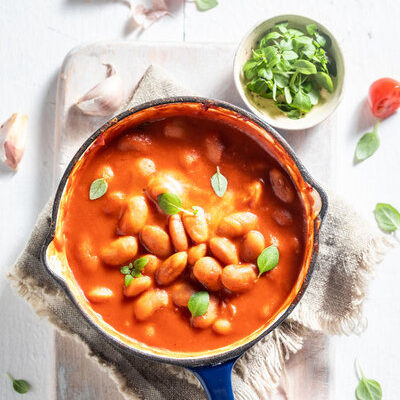
Kidney Beans
Also known as common bean, red kidney beans, cannellini beans
What are Kidney Beans?
Kidney beans (Phaseolus vulgaris) are an annual, sub-erect, or climbing herbaceous bush.
- They originate from the bean or legume family in the genus Phaseolus L, which was first found in South and Central America.
- This food got its name from its shape and color, which is why they are also sometimes referred to as red beans.
They have a mild flavor and are heavily loaded with vital nutrients, vitamins, and minerals. The two major varieties are dark red and light red, which differ in looks and flavor.
The most common varieties of this bean include:
- White kidney bean
- Red kidney bean
- Purple kidney bean
- Black kidney bean
- Spotted kidney bean
Origin of kidney beans
These beans were first discovered in Peru more than 7,000 years ago. At the time, many were familiar with a wide variety of beans. However, this crop was not known in the Old World. Migrating Indian traders brought this crop from Peru, and it spread all over Central and South America. Spanish explorers returning from several voyages to the New World eventually introduced kidney beans into Europe in the 15th century.
Later, Portuguese and Spanish traders introduced this crop into Asia and Africa. The English were the first to name this variety of beans as ‘kidney beans’ in 1551 to differentiate it from other types or varieties of beans in the Old World. Since beans have always been a highly inexpensive but rich source of protein, they became prevalent in many cultures. This food is usually considered the “meat of the poor” since it is a primary protein source for many communities worldwide.
Function
These beans have a buttery and soft interior texture that bring flavor to a wide variety of dishes. They make a popular addition to pasta, soups, and even salads. Also, these beans are commonly consumed in chili, rice dishes, and casseroles. Spanish, Portuguese, Caribbean, and Creole cuisines make heavy use of these beans.
Nutrition
100 grams (3.5 ounces) of well-cooked kidney beans contain:

This food is very rich in protein, which facilitates growth, boosts the immune system, and provides energy to the body. These beans also help build and repair body tissues. Additionally, they regulate blood sugar in the body. They even contain nutrients which can help prevent cancer.
Kidney beans are known to be high in fiber as they contain considerable amounts of resistant starch. Therefore, they play a significant role in weight management. However, red kidney beans are more toxic than other varieties since they contain high amounts of phytohemagglutinin. They can cause harm if not pre-soaked and then cooked for at least 10 minutes. Cooking them at a much lower temperature or in a slow cooker has been proven to raise their toxicity level five-fold.
Commercial Production
Kidney beans thrive if grown in USDA growing zones and warm temperatures between 64-78°F. Sowing this crop is much better than transplanting it, although ensure that you don’t plant the seeds too early in the spring, or they will rot. The harvesting of this food should be near after about 140 days. Then, the pods start drying out, and can be left to dry on the plant, especially if it is not too humid. It’s time to harvest this crop when the pods turn yellow or the color of straw.
After that, the plants are uprooted from the soil and hung upside down in a dry place to dry out the beans. Once the beans are cured, they can be kept in sealed containers for up to a year. Today’s largest producers of this crop are Brazil, China, Mexico, Indonesia, India, and the United States. Minnesota is the leading commercial producer of the red variety of this crop in the US. The global canned kidney beans market size is projected to reach up to $1.46 billion by 2026, with a CAGR of 3.47% from 2020 to 2026.
Application
Always drain and rinse dried red kidney beans before you cook them. You can do this by rinsing the beans and then pouring them into a saucepan. Cover the saucepan with an inch of clean water and bring to a boil. Let it boil for several minutes, then allow them to soak for at least 1 hour. Switch off the heat, drain, and add fresh water, then proceed with the recipe.
Dried kidney beans can last up to 1 year if stored in a cool, tightly sealed place. You can even consume the canned type of this food for 3-5 years. However, it is recommended that you check the button and ‘best by date’ on the can before purchasing it.
Kidney bean recipes
This food can be used in a variety of meals. Here are five recipes to try:
- Turkey Chili Taco Soup
- Chipotle Chicken Chili or “C3”
- Healthy Sloppy Joes
- Kidney Bean Soup
- Scrambled Eggs with Kidney Beans and Cheddar
FDA Regulation
The FDA has no regulations for this crop and do not regulate the growing, harvesting, and packaging of this crop, although they outline safety preparation tips. According to the FDA ‘Bad Bug Book,’ consuming this food raw poses a serious health challenge. The FDA strongly recommends soaking these dried beans in water for at least 5 hours, then pouring away the water. After that, red kidney beans should be boiled in fresh water for at least 30 minutes. This is to ensure that the beans reach a high enough temperature to obliterate the toxin.
References
U.S Food and Drug Administration. “Bad Bug Book: Foodborne Pathogenic Microorganisms and Natural Toxins Handbook.” Center for Food Safety & Applied Nutrition., https://www.med.navy.mil/sites/nmcphc/Documents/nepmu-6/Epidemiology/FDA-Food-Borne-Pathogens/Natural-Toxins/Phytohaemagglutinin.pdf
Ms, Gavin Van De Walle. “9 Important Functions of Protein in Your Body” Healthline.com, Healthline Media, 20 June 2018,, https://www.healthline.com/nutrition/functions-of-protein
Huffstetler, Erin. “How to Cook Dried Beans Perfectly.” The Spruce Eats, www.thespruceeats.com/dried-bean-cooking-times-1388321
BSc, Atli Arnarson. “Kidney Beans 101: Nutrition Facts and Health Benefits” Healthline.com, Healthline Media, 14 May 2019,, https://www.healthline.com/nutrition/foods/kidney-beans
